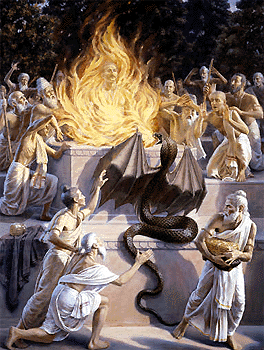Christus - Kristo - Krishna
|
|
Jesus (the son of Christ) talks about his father in heaven: "All things are delivered unto me by my Father: and no man knoweth the Son, but the Father; neither knoweth any man the Father, save the Son, and he to whomsoever the Son will reveal him." (Matthew 11:27) "No One Comes to the Father than through me."
One should go through Jesus through, to the father Christ or Krishna!
|
Tuesday, December 24, 2013
CHRISTUS- KRISTO- KRISHNA
Monday, December 23, 2013
SEXUAL ENERGY ON THE RIOT (A SPIRITUAL PERSPECTIVE ON THE TEJPAL SCANDAL)
By Chaitanya Charan das
The accusation of sexual abuse leveled against Tarun Tejpal, former Tehelka editor, highlights the dangerous riot of sexual energy in today’s culture. Irrespective of the truth of the allegation, the undeniable tragic truth is that sexual abuse, even if under-reported, is widespread in our society. But as long as such abuses happen in remote villages, mainstream India tends to ascribe it to the backwardness of those people.
However, as happened in the Nirbhaya gangrape case, when sexual abuse happens in the heart of mainstream society, in a bus on the streets of the national capital, and to someone who is very much a part of the forward-looking society – a medical student returning after watching a movie, that makes India sit up in alarm and take notice, in fact, march up in anger and demand action. The Nirbhaya case provoked national outrage and rightly so.
Friday, December 6, 2013
FEW WORDS ABOUT NELSON MANDELA













By Bhakti Caitanya Swami
In 1992, shortly after coming out of prison, but before he became President of South Africa, Nelson Mandela visited our Sri Sri Radha Radhanatha temple in Durban, South Africa. I got to show him around.
On the whole he was very nice, but the most interesting thing was when we went into the temple room. We took him over to see Srila Prabhupada, and he offered obeisances. Then he and I sat down on the other side of the temple room and spoke a little. I was explaining about our movement and what Srila Prabhupada did to establish it – how he travelled single handed from India and got everything started.
At one point Mr Mandela asked me, in a very pointed way, “how did he do it?” he was really struck by Srila Prabhupada and his achievements in the face of adversity. So I explained further about how Srila Prabhupada was spiritually empowered, and he appreciated that.
He also liked prasadam a lot.
Mr Mandela came to our temple again in 1994, when he was President, on an official visit. I was not there at the time, so I don’t know the details of that visit, but I understand it went very nicely.
Then in 1997 our Durban Food for Life devotees put on a large scale programme for 40,000 school children in a stadium, and Mr Mandela attended. He was only meant to stay for an hour or so, but he ended up staying for maybe four or five hours, and afterwards said it had been the happiest day of his life. That day he interacted no numerous occasions with different devotees, and saw very clearly that it was a Hare Krishna programme, so it certainly must have also made a great impact on his heart.
Now he has moved off to his next lifetime, but I’m sure there are significant benefits there on the transcendental platform for him
Thursday, December 5, 2013
THE PERSONIFICATION OF CHANTING SUKADEVA GOSWAMI

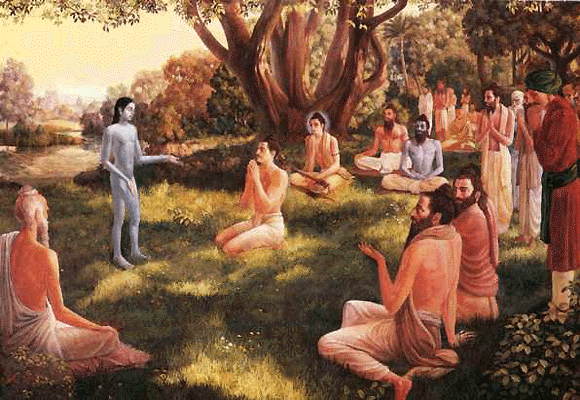
"So sravanam is so perfect also. Pariksit Maharaja attained perfection simply by hearing seven days. Similarly, Sukadeva Gosvami, he also attained perfection by speaking seven days to Pariksit Maharaja. Sravanam kirtanam visnoh smaranam."Srila Prabhupada Lecture on Srimad-Bhagavatam, 02-22-73, Auckland
THE PERSONIFICATION OF REMEMBERING

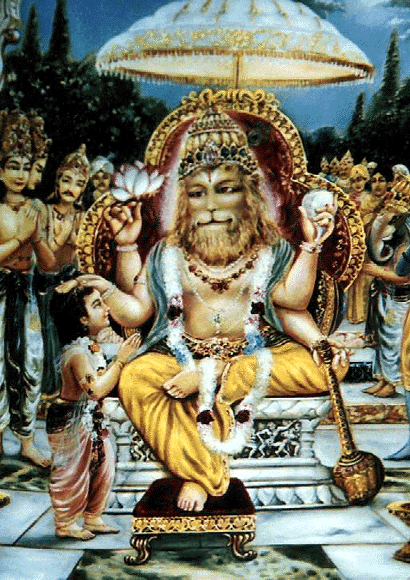
"Prahlada Maharaja, he was put into so many difficulties by his atheist father, Hiranyakasipu, but he was simply remembering Narayana, Krsna. Because he was a child, five years old, how he can fight with his father? His father was the greatest demon, powerful, and he was against the child. So he used to simply think of Krsna, smaranam."Srila Prabhupada Lecture on Srimad-Bhagavatam, 02-22-73, Auckland
THE PERSONIFICATION OF FRIENDSHIP WITH THE LORD

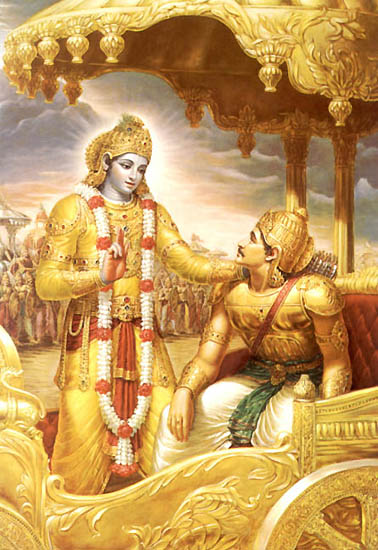
"....Krsna-sakha, Arjuna, is related with Krsna eternally. Eternally as friend. How eternally? What is the proof? There is in the Bhagavad-gita. When Arjuna inquired... When Krsna said that "This system of yoga I explained to the sun-god millions of years ago,"imam vivasvate yogam proktavan aham avyayam, at that time, to clear the idea, Arjuna, for our sake, he inquired, "My dear Krsna, we are contemporaries. You are born the other day along with me. How can I believe that millions of years ago You spoke this philosophy to the sun-god? So what is the answer?" The answer is, "My dear Arjuna, both you and Me, we take so many incarnations, but you forget. But I do not forget. I do not forget." Therefore Arjuna is always with Krsna. It is not that in this age, this millennium, Arjuna is friend of Krsna. No. He is eternal friend. He has made friendship with Krsna. It is never to be broken. It is never to be broken. So if you want to relish the rasa, the mellow, the taste of friendship, make friendship with Krsna. Krsna is prepared to make you friend. Therefore He comes: "Please come. Become My friend." But we are denying. Make Krsna your friend."Srila Prabhupada Lecture on Srimad-Bhagavatam, 10-23-74, Mayapur
MAHARAJA PARIKSIT THE PERFECTION OF HEARING

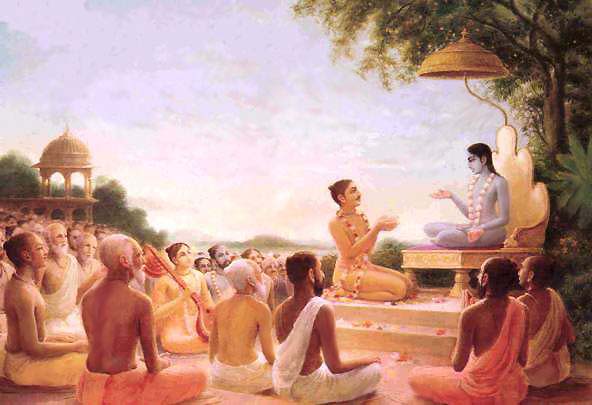
"Among the most intelligent of men was Maharaja Pariksit, the great king of the entire world, who was accidentally cursed by a brahmana to meet death from the bite of a serpent within seven days. The brahmana who cursed him was only a boy, yet he was very powerful, and because he did not know the importance of the great king, the boy foolishly cursed him to meet death within seven days. This was later lamented by the boy's father, whom the king had offended. When the king was informed of the unfortunate curse, he at once left his palatial home and went to the bank of the Ganges, which was near his capital, to prepare for his impending death. Because he was a great king, almost all the great sages and learned scholars assembled at the place where the king was fasting prior to leaving his mortal body. At last, Sukadeva Gosvami, the youngest contemporary saint, also arrived there, and he was unanimously accepted to preside at that meeting, although his great father was also present. The king respectfully offered Sukadeva Gosvami the principal seat of esteem and asked him relevant questions regarding his passing from the mortal world, which was to take place on the seventh day thenceforward. The great king, as a worthy descendant of the Pandavas, who were all great devotees, placed the following relevant inquiries before the great sage Sukadeva. "My dear sir, you are the greatest of the great transcendentalists, and therefore I submissively beg to ask you about my duties at this moment. I am just on the verge of my death. Therefore, what should I do at this critical hour? Please tell me, my lord--what should I hear, what should I worship, or whom should I remember now? A great sage like you does not stay at the home of a householder more than necessary, and therefore it is my good fortune that you have kindly come here at the time of my death. Please, therefore, give me your directions at this critical hour."
The great sage, having thus been pleasingly requested by the king, answered his questions authoritatively, for the sage was a great transcendental scholar and was also well equipped with godly qualities, since he was the worthy son of Badarayana, or Vyasadeva, the original compiler of the Vedic literature.
Sukadeva Gosvami said, "My dear king, your inquiry is very much relevant, and it is also beneficial for all people of all times. Such inquiries, which are the highest of all, are relevant because they are confirmed by the teachings of the vedanta-darsana, the conclusion of the Vedic knowledge, and are atmavit-sammatah; in other words, liberated souls, who have full knowledge of their spiritual identity, put forward such relevant inquiries in order to elucidate further information about the Transcendence." Nonetheless, all such gentlemen present themselves as great leaders of the people."Science of Self-Realization, Chapter 1
"Maharaja Pariksit met Sukadeva Gosvami just a week before his death, and the King was perplexed as to what should be done before he was to pass on. Many other sages also arrived there, but no one could give him the proper direction. Sukadeva Gosvami, however, gave this direction to him as follows: "My dear King, if you want to be fearless in meeting your death next week (for actually everyone is afraid at the point of death), then you must immediately begin the process of hearing and chanting and remembering God." If one can chant and hear Hare Krsna and always remember Lord Krsna, then he is sure to become fearless of death, which may come at any moment."Nectar of Devotion, Chapter 2
"In the Fourth Canto of Srimad-Bhagavatam, Twenty-ninth Chapter, verse 40, the importance of hearing of the pastimes of the Lord is stated by Sukadeva Gosvami to Maharaja Pariksit: "My dear King, one should stay at a place where the great acaryas [holy teachers] speak about the transcendental activities of the Lord, and one should give aural reception to the nectarean river flowing from the moonlike faces of such great personalities. If someone eagerly continues to hear such transcendental sounds, then certainly he will become freed from all material hunger, thirst, fear and lamentation, as well as all illusions of material existence."Nectar of Devotion, Chapter 10
"A short history of Maharaja Pariksit is that he was a very pious king, but unfortunately by some of his acts he was cursed by a brahmana boy to die within seven days. In those days if a brahmana should curse someone it would come true. They had the power to curse or give benediction.
So Pariksit understood that within a week he would have to die, and he prepared himself. He gave up his kingdom, entrusting it to his son, Maharaja Janamejaya, and he detached himself from the family and sat down on the banks of the Ganges near Delhi. It was not exactly the Ganges; it was actually the Yamuna. There, because he was a great emperor, many learned sages came.
Pariksit now inquired from all the great sages present there: "What is my duty? I am going to die within seven days; now what is my duty? You are all learned sages; please just prescribe for me." So someone said to practice yoga, some said to practice jnana, the cultivation of knowledge; there were different opinions. But at that time Sukadeva Gosvami entered the forest, and although Sukadeva was only sixteen, he was so learned and reputed that all the old sages, including his father, Vyasadeva, stood up to show him respect. He was so learned. So when he appeared, it was agreed. "Here is Sukadeva Gosvami. Let him decide what to do. We appoint him as our representative."
Sukadeva Gosvami was thus authorized to speak, and he was asked, "What is my duty? I am very fortunate that you have come in this momentous hour. Kindly tell me what is my duty."
Sukadeva Gosvami said, "All right, I shall explain to you the Srimad-Bhagavatam." Then everyone present agreed.
As the Bhagavatam was first spoken by Sukadeva Gosvami, it is therefore mentioned that as the parrot touches ripened fruit and it becomes even sweeter, so this Srimad-Bhagavatam, because it was touched first by Sukadeva Gosvami, has become still more tasteful."Topmost Yoga System, Chapter 8
"The position of Maharaja Pariksit and Sukadeva Gosvami is unique. Maharaja Pariksit is the right person to hear about the transcendental pastimes of Krsna, and Sukadeva Gosvami is the right person to describe them. If such a fortunate combination is made possible, then krsna-katha immediately becomes revealed, and people may benefit to the highest possible degree from such a conversation.
This narration was presented by Sukadeva Gosvami when Maharaja Pariksit was prepared to give up his body, fasting on the bank of the Ganges. In order to assure Sukadeva Gosvami that by hearing krsna-katha he would not feel tired, Maharaja Pariksit expressed himself very frankly: "Hunger and thirst may give trouble to ordinary persons or to me, but the topics of Krsna are so nice that one can continue to hear about them without feeling tired because such hearing situates one in the transcendental position." It is understood that one must be very fortunate to hear about krsna-katha seriously, like Maharaja Pariksit. He was especially intent on the subject matter because he was expecting death at any moment. Every one of us should be conscious of death at every moment. This life is not at all assured; at any time one can die. It does not matter whether one is a young man or an old man. So before death takes place, we must be fully Krsna conscious.
At the point of his death, King Pariksit was hearing Srimad-Bhagavatam from Sukadeva Gosvami. When King Pariksit expressed his untiring desire to hear about Krsna, Sukadeva Gosvami was very pleased. Sukadeva was the greatest of all Bhagavata reciters, and thus he began to speak about Krsna's pastimes, which destroy all inauspiciousness in this Age of Kali. Sukadeva Gosvami thanked the King for his eagerness to hear about Krsna, and he encouraged him by saying, "My dear King, your intelligence is very keen because you are so eager to hear about the pastimes of Krsna." He informed Maharaja Pariksit that hearing and chanting of the pastimes of Krsna are so auspicious that the processes purifies the three varieties of men involved: he who recites the transcendental topics of Krsna, he who hears such topics, and he who inquires about Him. These pastimes are just like the Ganges water which flows from the toe of Lord Visnu: they purify the three worlds, the upper, middle and lower planetary systems."Krsna Book, Introduction
"Sukadeva Gosvami imparted transcendental knowledge to Maharaja Pariksit during the remaining seven days of his life, and Maharaja Pariksit heard him properly, just like an ardent student. The effect of such a bona fide hearing and chanting of Srimad-Bhagavatam was equally shared by both the hearer and the chanter. Both of them were benefited. Out of the nine different transcendental means of devotional service to the Lord prescribed in the Bhagavatam, either all of them, or some of them or even one of them are equally beneficial if properly discharged. Maharaja Pariksit and Sukadeva Gosvami were serious performers of the first two important items, namely the process of chanting and the process of hearing, and therefore both of them were successful in their laudable attempt. Transcendental realization is attained by such serious hearing and chanting and not otherwise. There is a type of spiritual master and disciple much advertised in this age of Kali. It is said that the master injects spiritual force into the disciple by an electrical current generated by the master, and the disciple begins to feel the shock. He becomes unconscious, and the master weeps for his exhausting his store of so-called spiritual assets. Such bogus advertisement is going on in this age, and the poor common man is becoming the victim of such advertisement. We do not find such folk tales in the dealings of Sukadeva Gosvami and his great disciple Maharaja Pariksit. The sage recited Srimad-Bhagavatam in devotion, and the great King heard him properly. The King did not feel any shock of electrical current from the master, nor did he become unconscious while receiving knowledge from the master. One should not, therefore, become a victim of these unauthorized advertisements made by some bogus representative of Vedic knowledge. The sages of Naimisaranya were very respectful in hearing about Maharaja Pariksit because of his receiving knowledge from Sukadeva Gosvami by means of ardent hearing. Ardent hearing from the bona fide master is the only way to receive transcendental knowledge, and there is no need for medical performances or occult mysticism for miraculous effects. The process is simple, but only the sincere party can achieve the desired result."Srimad-Bhagavatam 1:12:3 Purport
Bhaktivedanta Book Trust. HDG A.C. Bhaktivedanta Swami Srila Prabhupada.
THE PERSONIFICATION OF DEITY WORSHIP LAXMI DEVI
Laksmi Devi - The Personification of Deity Worship
BY: SUN STAFF
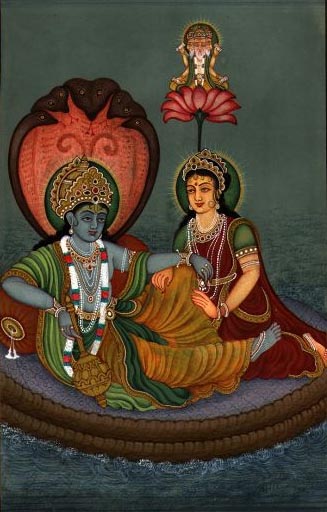 Laksmi Worshipping the Lotus Feet of Visnu
Laksmi Worshipping the Lotus Feet of Visnu
Nov 29, 2013 — CANADA (SUN) — Transcendental personalities who personify the nine devotional practices.
"Mother Laksmiji, the goddess of fortune, is well known for always massaging the lotus feet of Lord Narayana. She is an ideal wife because she takes care of Lord Narayana in every detail. She takes care not only of His lotus feet but of the household affairs of the Lord as well. She cooks nice foods for Him, fans Him while He eats, smoothes sandalwood pulp on His face and sets His bed and sitting places in the right order. In this way she is always engaged in the service of the Lord, and there is hardly any opportunity for any other devotee to intrude upon His daily activities."
Srimad-Bhagavatam 4:20:28
PRTHU MAHARAJA - THE PERSONIFICATION OF TEMPLE SERVICE
Prthu Maharaja - The Personification of
Temple Service
Temple Service
BY: SUN STAFF
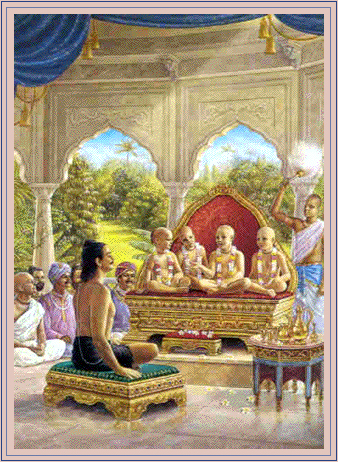
Nov 30, 2013 — CANADA (SUN) — Transcendental personalities who personify the nine devotional practices.
"Prthu Maharaja was the ideal Vaisnava king; therefore he taught others by his personal behavior how to receive and respect saintly persons like the Kumaras. When a saintly person comes to one's home, it is the Vedic custom first to wash his feet with water and then sprinkle this water over the heads of oneself and one's family. Prthu Maharaja did this, for he was an exemplary teacher of the people in general."
Srimad-Bhagavatam 4:22:5
THE PERSONIFICATION OF OFFERING PRAYERS
Akrura - The Personification of Offering Prayers
BY: SUN STAFF
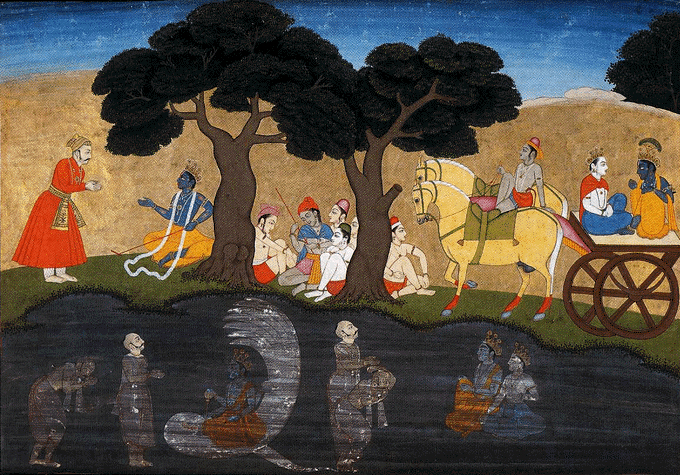
Bhagavat Purana - Basholi, c. 1760
Dec 01, 2013 — CANADA (SUN) — Transcendental personalities who personify the nine devotional practices.
"Akrura: The commander in chief of the Vrsni dynasty and a great devotee of Lord Krsna. Akrura attained success in devotional service to the Lord by the one single process of offering prayers. He was the husband of Sutani, daughter of Ahuka. He supported Arjuna when Arjuna took Subhadra forcibly away by the will of Krsna. Both Krsna and Akrura went to see Arjuna after his successful kidnapping of Subhadra. Both of them presented dowries to Arjuna after this incidence. Akrura was present also when Abhimanyu, the son of Subhadra, was married with Uttara, mother of Maharaja Pariksit. Ahuka, the father-in-law of Akrura, was not on good terms with Akrura. But both of them were devotees of the Lord."
Srimad-Bhagavatam 1:11:167
"Lord Sri Krsna was very pleased by Akrura's offering of prayers. His smile was captivating Akrura more and more. The Lord replied to him as follows: "My dear Akrura, in spite of your submissiveness, I consider you My superior, on the level with My father and teacher and most well-wishing friend. You are, therefore, worshipable by Me, and since you are My uncle, I am always to be protected by you. I desire to be maintained by you because I am one of your own children. Apart from this filial relationship, you are always to be worshiped. Anyone who desires good fortune must offer his respectful obeisances unto personalities like you, you are more than the demigods. People go to worship the demigods when they are in need of some sense gratification; the demigods offer benediction to their devotees after being worshiped by them. But a devotee like Akrura is always ready to offer the greatest benediction to the people. A saintly person or devotee is free to offer benediction to everyone, whereas the demigods can offer benediction only after being worshiped. One can take advantage of the place of pilgrimage only after going there. By worshiping a particular demigod, it takes a long time for the fulfillment of the desires; but saintly persons like you, My dear Akrura, can immediately fulfill all the desires of the devotees. My dear Akrura, you are always Our friend and well-wisher. You are always ready to act for Our welfare."
Krsna Book, Chapter 48
DASYA SERVITORSHIP BHAKTA HANUMAN BY THE SUN
Hanuman - The Personification of Servitorship
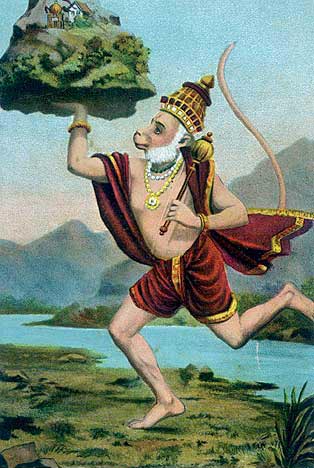
Dec 02, 2013 — CANADA (SUN) — Transcendental personalities who personify the nine devotional practices.
"Yes, the nine devotional process and how, by each process, one becomes perfect, just like Pariksit Maharaja, simply hearing, and Sukadeva Gosvami, simply chanting, reciting Bhagavatam. So both of them got salvation. Laksmi, she is simply pada-sevanam, giving massage to the lotus feet of the Lord. Arjuna simply made friendship with Krsna. Hanuman simply worked as a hard servant. He doesn't know what He is... "Lord Ramacandra wants it." Then it is done. Jump over. He does not know any philosophy. He has got bodily strength, so whatever Ramacandra says, he'll do. He was asked to bring that medicine for Laksmana. He did not know where to find it. "Take this whole mountain." (laughter) He was not intelligent. "Fight! We have to fight with Ravana. Then block his whole city by throwing stones and trees and dirt." Everything became blocked. They could not move. So in one side he is born of animal life, he had no higher intelligence, but his staunch desire, that "I shall serve Lord Ramacandra..." By that... Only this desire made him perfect."
Tuesday, December 3, 2013
FEMALE DIKSHA GURU — SOME CONSIDERATIONS BY BASU GHOSH DAS
Female Diksha Guru — some considerations
1,772 Views / EMail This Post / Print This Post / Home » Female Diksha Guru -- some considerations By Basu Ghosh Das
By Basu Ghosh Das
There is a definite “push” for a female diksha guru in ISKCON that is the proverbial “elephant in the room”, as the title of the recent article on Dandavats.com by Devaki Mataji alluded to.
The eagerness of a section of devotees to see a female blessed as diksha guru in ISKCON posthaste is akin “affirmative action” in the USA, as well as the reservation system for the backward classes here in India. Call it “social engineering”, if you want. The mood is “let’s have a token woman diksha guru” to affirm that women are equal to men in ISKCON.
This arises from the egalitarian outlook of modern Western society and the various equal rights movements so popular in the Western world, and is an ideology that runs contrary to Srila Prabhupadas’s teachings and the ancient culture he was eager to transplant from India, worldwide.
To begin with, when a woman can’t wear the sacred thread – the yajnopavita – then how can she give one as a part of initiation? Srila Prabhupada followed the system of initiation introduced by Srila Bhaktisiddhanta Saraswati Thakur. Srila Saraswati Thakur introduced the brahmin thread – yajnopavita – for persons not born in brahmana families.
Traditionally, brahmanas, kshatriyas, and vaishyas were initiated with the yajnopavita in order to study the vedas and then perform vedic sacrifices. They are the “dvijas” – the twice born, as upanayanam (“bringing closer”) samskara was performed in their communities.
Srila Prabhupada introduced such initiations – for men. For women, he never conferred the yajnopavita! Therefore, how can a woman give a sacred thread as a part (“anga” in Samskritam) of “diksha” if she herself does not/cannot wear it? This historical fact should be sufficient in itself as evidence that women were not to be diksha gurus.
Prabhupada’s now well know comment in his purport to Srimad Bhagavatam 4.12.32 is a direct comment on this:
“According to sastric injunctions, there is no difference between siksha-guru anddiksha-guru, and generally the siksha-guru later on becomes the diksha-guru. Suniti, however, being a woman, and specifically his mother, could not becomeDhruva Maharaja’s diksha-guru”.
Srila Saraswati Thakur and Srila Prabhupada envisioned the revival of vedic culture and “daivi varnashram”. Lord Krishna states in Bhagavad-gita that He Himself created varnashram dharma:
“According to the three modes of material nature and the work associated with them, the four divisions of human society are created by Me. And although I am the creator of this system, you should know that I am yet the nondoer, being unchangeable.” (Bhagavad-gita 4.13)
In the varnashram system, women are envisioned as belonging to the varna of their husband. The following verses in Manu Samhita clearly indicate that:
“Whatever be the qualities of the man with whom a woman is united according to the law, such qualities even she assumes, like a river (united) with the ocean. Akshamala, a woman of the lowest birth, being united to Vasishtha and Sarangi, (being united) to Mandapala, became worthy of honour. These and other females of low birth have attained eminence in this world by the respective good qualities of their husbands.” (Manu 9. 22-24)
After the battle of Kurukshetra, when Bhishmadev was lying on the bed of arrows (baan shayaa), Lord Krishna took Maharaj Yudhishtir to him so that Bhishma would instruct him on the various aspects of dharma.
In this regard there is the following verse in the Bhagavatam:
dana-dharman raja-dharman
moksha-dharman vibhagasah
stri-dharman bhagavad-dharman
samasa-vyasa-yogatah
“He (Bhishmadev”) then explained, by divisions, acts of charity, the pragmatic activities of a king and activities for salvation. Then he described the duties of
women and devotees, both briefly and extensively.” [Srimad Bhagavatam 1.9.27].
From this it is crystal clear that the Bhagavatam states that women have their own specific and separate set of duties, distinguished from those of men.
Srila Prabhupada voiced this in simple language on several occasions. Here are two examples of those expressions:
A woman’s real business is to look after household affairs, keep everything neat and clean, and if there is sufficient milk supply available, she should always be engaged in churning butter, making yogurt, curd, so many nice varieties, simply from milk. The woman should be cleaning, sewing, like that.
(Srila Prabhupada in a letter to female disciple, February 16, 1972)
(Srila Prabhupada in a letter to female disciple, February 16, 1972)
Prabhupada: We shall teach the girls two things. One thing is how to become chaste and faithful to their husband and how to cook nicely… These two qualifications required. She must learn how to prepare first-class foodstuff, and she must learn how to become chaste and faithful to the husband. Only these two qualification required. Then her life is successful. Educate the girls how to become faithful, chaste wife and how to cook nicely. Let them learn varieties of cooking. Is very difficult? And by fifteenth, sixteenth year they should be married. And if they are qualified, it will be not difficult to find out a nice husband. Here the boys, they do not want to marry because they are not very much inclined to marry unchaste wife. They know it, that “I shall marry a girl, she is unchaste.” What do you think?
(Srila Prabhupada on his morning walk, July 10, 1975, at Chicago, USA)
(Srila Prabhupada on his morning walk, July 10, 1975, at Chicago, USA)
And Srila Prabhupada’s letter to Arundhati Devi Dasi dated July 30, 1972:
“Child-worship [for female, grihini] is more important than deity-worship. If you cannot spend time with him [alluding to her son], then stop the duties of pujari. At least you must take good care of your son until he is four years old, and if after that time you are unable any more to take care of him then I shall take care…”.
The point is that women were encouraged by Srila Prabhupada and vedic/vaishnava /Indian tradition to be grihini – housewife, which is the most important duty for women. Grihini’s act as mother, grandmother, cook, cleaner, and guide to the children in the home.
We don’t find in any of the shastras that women studied or taught the vedas, nor wore the yajnopavita (sacred thread). Srila Prabhupada and Srila Bhaktisiddhanta Saraswati Thakur did not indicate that we should change this ancient vedic tradition by having women take up these activities.
The pro-female diksha guru devotees cite Jahhava Mata, Gangamata Goswamini, and others who Srila Prabhupada recognized as “gurus”.
However, from Gaudiya vaishnava history it can be understood that these exalted ladies were “shiksha gurus” and that such exalted personalities were exceptional cases Srila Prabhupada only mentioned these two or three ladies as gurus.
According to the Taitiriya Upanishad, mother is the first guru as per the famous mantra: “matri devo bhava, pitri devo bhava, acharya devo bhava, atithi devo bhava”.
Some proponents of female diksha guru state that there were “hundreds” of women gurus in the Gaudiya Sampradaya. However, upon close investigation of their names, we see that these women were from the “caste goswami lines” (the “parivaars” – “families”/family lines), that were rejected by Srila Bhaktisiddhanta Saraswati Thakur and Srila Prabhupada.
“In India there are still superstitions that one should be initiated by someone from such a sukaracharya family. They are called generally the jatigosain. Jatigosain means the caste spiritual masters. All over India, especially in Bengal, this jatigosain spiritual mastership is very prevalent. But really goswami means one who is master of the influence of different senses, namely the influence of anger, the influence of the belly, the influence of the genitals, and the influence of talking. So one who is master of these influential webs of sense gratification, he is called goswami. Goswami is not by hereditary chart. So Sukaracharya posed himself as such a goswami spiritual master. He had many mystic powers; therefore, he was considered to be a very influential spiritual master of the demons”.
[Srila Prabhupada as quoted in Srila Prabhupada lila by Satsvarupa das Goswami, in Chapter 3]
Then we have the example from the Srimad Bhagavatam of Lord Krishna and Balaram residing at the home of the guru, Sandipani at Avanti (today Ujjain):
“Concealing Their innately perfect knowledge by Their humanlike activities, those two omniscient Lords of the universe, Themselves the origin of all branches of knowledge, next desired to reside at the school of a spiritual master. Thus They approached Sandipani Muni, a native of Kasi living in the city of Avanti.” [Srimad Bhagavatam 10.45.30/31]
Sandipani Muni was Lord Krishna’s guru and his wife was “guru patni”, the
wife of the guru. He is addressed as the guru, not his wife. We do not find her addressed as “gurvi”, the feminine form of the word guru in Samskritam. [Like “prabhvi” is the feminine form of the word “prabhu”].
In fact, in all the vedic/Samskrita literatures and histories we don’t find reference to even one woman guru! That is because women were trained in the vedic culture to be grihini – housewives, and engage in their natural dharma – household work.
The five “panchakanyas”, famous women in vedic literatures, were famous for their devotion to their husbands, not for guruship:
ahalyaa draupadi sita taaraa mandodari tatha
panchakanyah smarennityam mahapatakanshiniḥ
“Ahalya, Draupadi, Sita, Tara and Mandodari. One should forever remember these panchakanyas who are the destroyers of great sins”.
If a woman were to give up her home life and become a traveling preacher, which is the duty of sannyasis, then it would be a cause for her falldown, according to the Manu Samhita:
Panam durjana sangasya patya cha viraho’tanam svapno’nyagehvashcha naari sandushanaani shat
“Drinking (spirituous liquor), associating with wicked people, separation from the husband, rambling abroad, sleeping (at unseasonable hours), and dwelling in other men’s houses, are the six causes of the ruin of women”. (Manu 9.13)
It is said that the sannyasis are the guru of the brahmanas and the brahmanas are the gurus of society.
In his lecture during sannyas initiation at Mayapur on March 16,1976, Prabhupada stated this:
“So guru is the post given to the sannyasis, to the brahmaṇas. Without becoming abrahmaṇa, nobody can become a sannyasi, and sannyasi is supposed to be the guruof both all the ashramas and all the varnas. So the preaching work… We require so many sannyasis”.
This fact further supports the contention that women were to be grihini, housewife. Srila Prabhupada and Srila Bhaktisiddhanta Saraswati Thakur did not initiate a single female into the sannyas ashram.
Prabhupada: In the history of India there is no woman leader. Throughout
Mahabharata you’ll find… Mahabharata is the greater history, history of
greater India. Maha means “greater,” and bharata. So “Greater Bharata.” That
means this whole planet. So you won’t find woman leader”.
[Srila Prabhupada in a room conversation March 24, 1977, Bombay, regarding
Indira Gandhi].
Woman reporter: And if women were subordinate to men, it would solve all of
our problems?
Prabhupada: Yes. Man wants that woman should be subordinate, faithful to him. Then he is ready to take charge. The man’s mentality, woman’s mentality different. So if the woman agrees to remain faithful and subordinate to man, then the family life will be peaceful.
(Newspaper interview with Srila Prabhupada, July 9, 1975, Chicago)
Devaki Mataji, in her article “The Hot Issue, Female Diksha Guru”, attempted to echo Srila Prabhupada’s and vedic/vaishnava tradition’s views on women and their duties, and the fact that becoming a diksha guru for a women is incongruent with those duties – known as “stridharma”.
The quotes above and so many other quotes, and the history and tradition of vedic culture preserved by the parampara, system of disciplic succession, teach us just what is stated herein above, that diksha guru is the occupation of a brahmana, and not the occupation for women, who have their own dharma.
Prabhupada’s conversation with Tamal Krishna Maharaj gives us gives us further indication of this:
Prabhupada: So far gurukula is concerned, that also, I have given program. They have given the name of “girls.” We are not going to do that.
Tamala Krsna: What is that?
Prabhupada: Girls. Boys and girls. That is dangerous. Girls should be completely separated from the very beginning. They are very dangerous.
Tamala Krsna: So we’re… I thought there were girls in Vrndavana now. They said that they’re going to have the girls’ gurukula behind the boys’ gurukula. Gopala was talking about that.
Prabhupada: No, no, no. No girls.
Tamala Krsna: It should be in another city or somewhere else.
Prabhupada: Yes. They should be taught how to sweep, how to stitch, clean, cook, to be faithful to the husband.
Tamala Krsna: They don’t require a big school.
Prabhupada: No, no. That is mistake. They should be taught how to become obedient to the husband.
Tamala Krsna: Yeah, you won’t learn that in school.
Prabhupada: Little education, they can…
Tamala Krsna: Yeah. That they can get at home also.
Prabhupada: They should be stopped, this practice of prostitution. This is a very bad system in Europe and America. The boys and girls, they are educated, coeducation. From the very beginning of their life they become prostitutes. And they encourage. They distribute pills. I have seen the boys and girls dancing together, embracing, in the school film. That ruins the career. Both of them are ruined. That is very regrettable. Then you shall require this sterilization, pills, another big program. They are creating animal civilization, and when the animals are disturbing, they are trying to find out some other means. This is their program. First of all create animals. Then, when the animals behave like animals, then another program. Why do you create animal? Woman brahmacarini, this is artificial.
Tamala Krsna: In our centers, though, there are so many brahmacarinis, and even sometimes they’re encouraged to remain brahmacarini.
Prabhupada: That they cannot. As soon as they will find opportunity, they will become vyabhicarini [sexually deviated]. For woman, protection.
Tamala Krsna: So you don’t advocate this remaining sing…, these women remaining brahmacarinis.
Prabhupada: Therefore polygamy was allowed. Let them be taken care of, one husband, three wives.
(Prabhupada’s conversation at Bombay on April 29, 1977)
If the example of a female guru is allowed to be established within ISKCON, it would certainly inspire other women to do likewise, and that would set the wrong example, as it is in contradiction with Prabhupada’s teachings.
The rationalization and justification for establishing female diksha guru in ISKCON is born out of Western liberal, egalitarian thought, and not based on the teachings of Srila Prabhupada, Srila Saraswati Thakur and our previous acharyas.
Thus it would be a shame for us to change ancient vedic culture and the traditions of vaishnavism so as to make our movement acceptable to “popular modern thought” prevalent in the mleccha and yavana West! Srila Prabhupada set the example by not doing so, and we would be wise follow his example. Srila Prabhupada never appointed one woman as GBC or Temple President, what to speak of dikha guru.
The late Dr. Stillson Judah, a Western religious scholar who dialogued with and befriended Srila Prabhupada wrote: in his 1974 book “Hare Krishna and the Counterculture”:
“‘The position of women in the [ISKCON] Society may not appeal to Americans interested in women’s liberation. Swami Bhaktivedanta says that all women other than one’s wife are to be considered as one’s mother, and yet he regards them as prone to degradation, of little intelligence, and untrustworthy. They should not be given as much freedom as men, but should be treated like children; they should be protected all during their lives, by their fathers when young, later by their husbands, and in their old age, by their sons … This view is largely consonant with the traditional one found in the ancient Indian law books. Females may not become presidents of any temple, nor occupy positions of authority. They may do the cooking, help with the devotional services and maintenance of the temple and prepare the flower offerings for Krishna.”‘ (Judah, 1974:86)
The conclusion is that establishing women as diksha gurus contradicts the concepts that Srila Prabhupada taught above the duties of women, as well as the example Srila Prabhupada himself set when managing his ISKCON society.
Monday, December 2, 2013
YOU ARE TAUGHT WRONG THEORIES ON CREATION OF UNIVERSE
You Are Taught Wrong Theories on Creation of Universe
Big Bang Theory is False and Full of Flaws
The Somehow Theory of Modern Science extended even to cosmology which Scientists should be ashamed of before claiming to be experts of Science and Cosmology
The recent scientific theory of creation is that there was a big bang, which created the material elements (earth, water, gases, chemicals etc..). These material elements then somehow combined together and created the various planets somehowand one species of living beings somehow. These living beings then somehow changed their bodies and became another species, and so on. In this way the millions of species of living beings we know of were created – SOMEHOW ?!. This unproven theories are backed by another theory termed as evolution, thus one body changes into another and so on.
The scientific theory of creation leaves many unanswered questions.
- What or who caused the big bang?
- How earth, water, gases, chemicals were created, when there was nothing to create them?
- If a big bang created all the Universes and millions of Planets. Then according to this scientific logic, it should be possible to create a small planet or something with a small bang. Can any scientist create anything with a bang?
- Some chemicals mixed together created the first living being. The scientists have all the chemicals in the world; can they mix them and create a living being?
- What gave life to those living beings, how they came to know their natural simulation?
- All the millions of planets are shaped like a sphere, is this by chance?
- The sun has been giving exact amount of sunlight to the various planets including Earth for millions of years. Is this by chance? Too much sun or too little can destroy all life on Earth. Even +/-10 percent rise/drop of sudden change in temperature cause huge climatic change in Earth. How is this managed so precisely by whom?
- If Evolution theory is correct – then why not even single intermediate staged fossil of even single species were found by these Scientists or Physicists – that could have shown that evolution lead to species changing shapes.
It is already shown in previous posts that Evolution is/was a convenient way for the Scientists to shy away from logical explanation of emergence of such vast variety of animals, plants and aquatic lives.
Click on the image below for enlarged view
Top Big Bang rebuttals highlighted by Michael Turner
(1) Static universe models fit observational data better than expanding universe models.
Static universe models match most observations with no adjustable parameters. The Big Bang can match each of the critical observations, but only with adjustable parameters, one of which (the cosmic deceleration parameter) requires mutually exclusive values to match different tests. Without ad hoc theorizing, this point alone falsifies the Big Bang. Even if the discrepancy could be explained, Occam’s razor favors the model with fewer adjustable parameters – the static universe model.
16 VEGAN CELEBRITIES WHO'VE GIVEN UP ANIMAL PRODUCTS FOR A HEALTHIER LIFESTYLE
( Articulo por el diario Huff Post)
More people than you may have thought are on plant-based and animal-free diets:PETA reports that 2.5 percent of U.S. residents are vegans, while another 5 percent are vegetarians. Celebrities are no strangers to these dietary changes; big names like Bill Clinton, Ellen DeGeneres and now Al Gore are all on board with veganism.
Just how nutritious is this plant-based diet, though? Experts note it can be one of the healthiest ways to eat, as you’ll limit calories and harmful fats while still consuming vitamins and minerals. It’s also good for the environment; it uses fewer resources, and doesn’t support industrial livestock farms, which often face criticism for their treatment of animals and environmental waste.
Many celebrities have adopted the diet for personal, health, or environmental reasons, and are speaking up for this lifestyle. Take a look at some of veganism’s most prominent supporters below.
- Bill Clinton
 Getty ImagesAfter undergoing quadruple bypass surgery in 2004 and a later stent surgery, the 42nd president adopted a vegan diet in 2010. He's since lost 20 pounds, and has become an advocate for vegan and meatless diets.
Getty ImagesAfter undergoing quadruple bypass surgery in 2004 and a later stent surgery, the 42nd president adopted a vegan diet in 2010. He's since lost 20 pounds, and has become an advocate for vegan and meatless diets.
"I like the vegetables, the fruits, the beans, the stuff I eat now," Clinton told a CNN reporter. "All my blood tests are good, and my vital signs are good, and I feel good, and I also have, believe it or not, more energy."
(Photo By Michael Reynolds-Pool/Getty Images)
Subscribe to:
Posts (Atom)
The Transformation of a Wicked Brāhmaṇa through Ekādaśī
In a once-prosperous town, there lived a brāhmaṇa whose conduct was far from noble. Though born in a family of learning and piety, he had fa...

-
Quotes from Srimad Bhagavatam: äpannaù saàsåtià ghoräà yan-näma vivaço gåëan tataù sadyo vimucyeta yad bibheti svayaà bhayam Living be...
-
Full size image Ekadasi Vrata To observe Ekadasi-vrata and Dvadasi-vrata means to please the Supreme Personality of Godhead . Th...


